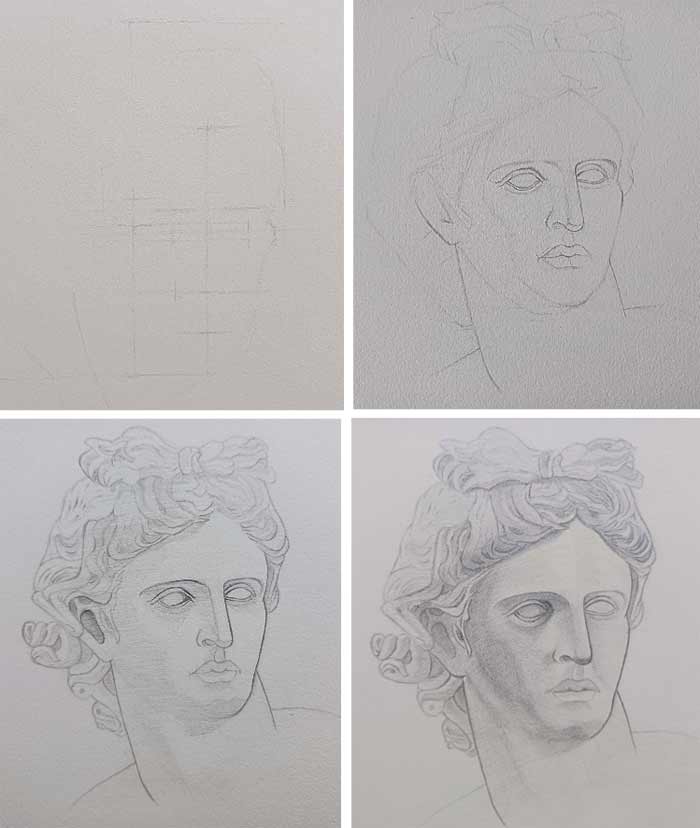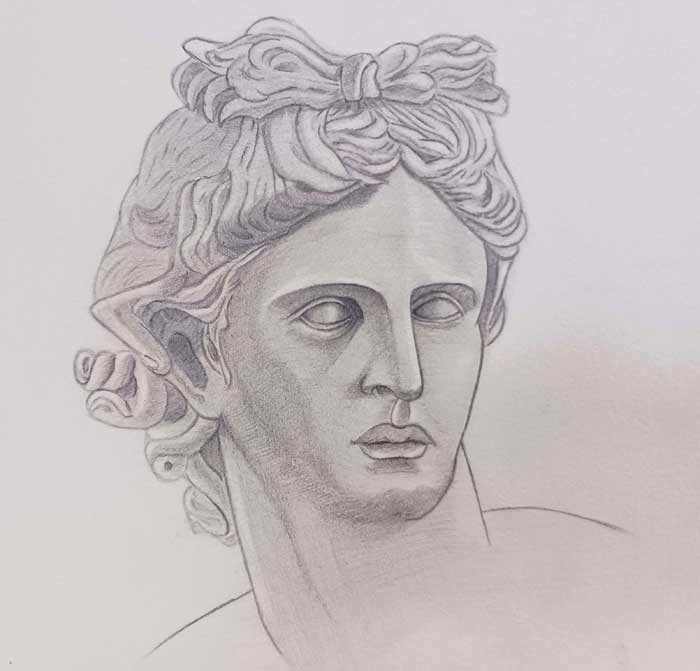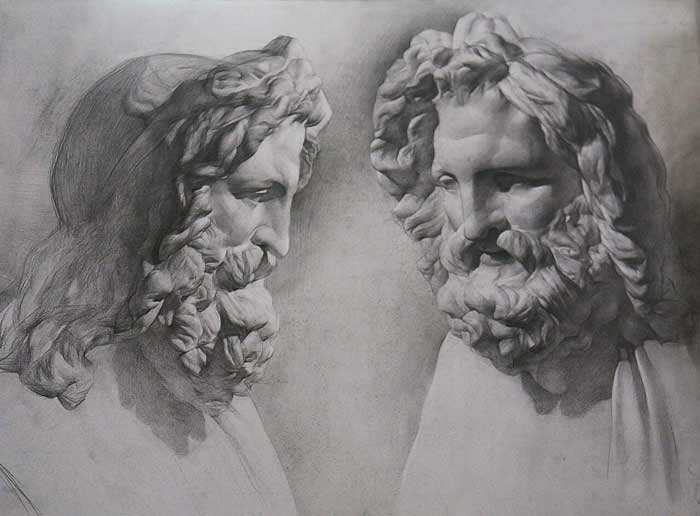Artworks from Michael, Drawing Academy student
Dear Drawing Academy,
I have just completed a drawing of Apollo. Here are several pictures of the steps I took.


I am looking forward to your critique.
Sincerely,
Michael
Dear Michael,
Thank you for your step-by-step drawings. It is very good that you take interest in drawing portraits.
Because you did not include the entire paper sheet into your photo, I cannot comment on this artwork layout and scale, but it looks like you used the landscape layout instead of portrait, which tells that you have insufficient experience with composition.
It is good that you begin drawing with helping lines of levels and proportions. At the same time, those lines are about “measuring what you see” instead of “drawing what you know” because in the three-quarters view the central line of a face is not straight, but curved, so are the other levels. There are many key points that are missing, which are rather critical for constructive drawing. For example, the construction of how the head connects to the neck and neck to the shoulders is not described at all. The mouth is displaced. The eyes are not on the same level. The upper lip groove is skewed. The shoulders do not form one object. The anatomy of an ear is wrong. This once again tells that you draw what you see rather than “build” a portrait with knowledge. For example, because knowledge of anatomy is missing, you do not see mistakes in ear cartilages.
All outlines and contours in this artwork are very bold, especially in the final result. You cut out the head and features, which is an amateur approach because in real life, there are no lines, but borders between planes with different tonal values. Talking of tonal rendering, there is a lot to improve. You apply pencil strokes without regard to geometric forms of this sculpture and ignoring important contours and planes, which should be used to reveal the three-dimensional construction of a head. It looks like you smudged graphite pencil marks, which resulted in mud and instead of making an illusion of depth and volume, you end up with flat and dirty shapes. Here’s the thing. No matter how hard you will try rendering light and shadow, a drawing will appear flat if you miss pout the main purpose of hatching, which is not to decorate some shapes with tonal values, but to reveal their 3D construction by means of applying pencil strokes along contours, defining in hatching planes at different angles and “telling a story” about how light hits various planes at different angles, as well as reflects and bounces from nearby places. When it comes to the hairstyle, it has no volume nor depth. To complete this short review, I have to mention that the aerial perspective is completely missing. You won’t see such a perspective in life when drawing a portrait, but a proficient artist should draw what one knows. Because such knowledge is missing, there is no hope that you would “accidentally” create an atmospheric depth in this drawing.
Portrait drawing as a genre is challenging for you not just because some special knowledge of portraiture is missing, such as skull and head construction, proportions, anatomy, and so on, but because much more fundamental drawing skills are undeveloped. Such skills include handling a pencil, for example. Your hand does not hatch good quality lines on autopilot. This skill depends on muscle memory and such memory only comes with practice. However, here’s the thing – should you practice wrong technique for a long time, you will become perfect at hatching bad lines. Other mistakes, like miss-leveling eyes, tell that you do not have sufficient practice of constructive drawing. It is not about construction of a head, but construction of much simpler objects like a cube, cone, cylinder, sphere etc. If an artist cannot draw a perfect cube in linear and aerial perspective there is no hope that one would draw a perfect portrait without distortions. This is because seeing mistakes comes from drawing simple things. For example, two eyes are just two balls, literally. If you did not spend enough time on drawing sphere models from life, you would not see mistakes when drawing eyes. In your artwork, eyes are not spherical, but cylindrical. I’m not talking about the eyelids’ shapes, but the geometric construction of eyeballs behind. Those two cylinders in your portrait have doubtful tonal rendering because each has a different light source, which makes eyes spooky. A student who has enough experience of rendering tonal values of a sphere, would not have troubles with rendering eyes because the approach is exactly the same. However, if you jump over many topics of drawing to draw portraits, the result would look amateur no matter how hard you try. It’s like attempting to write a poem in Japanese when you have no idea about Japanese characters, grammar, and vocabulary. To you, your Japanese poem might sound good, but to any person who knows this language it would be very obvious that this is just a collection of strange characters accidentally placed together.
This should not stop you from drawing portraits. By all means draw from life, memory and imagination. But to be proficient in portrait drawing, you need to learn simpler and more fundamental skills. Before you will be able to make such drawings as below, you need to cover many basic things.

If you want to get strong drawing skills, you need professional art teachers. On your own, even with occasional critique, it would be next to impossible to get out of an “amateur-skills trap”. The history of arts does not feature a single great artist who was self-taught. Here’s the decision you need to take – continue struggle on your own, or get it right and take personal one-to-one tutoring from professional fine artists and teachers.
Here’s the link to enroll in the Life Drawing Academy Correspondence Course where you will get a dedicated art teacher and unlimited personal tutoring:
https://lifedrawing.academy/correspondence-course
Kind regards,
Vladimir London




